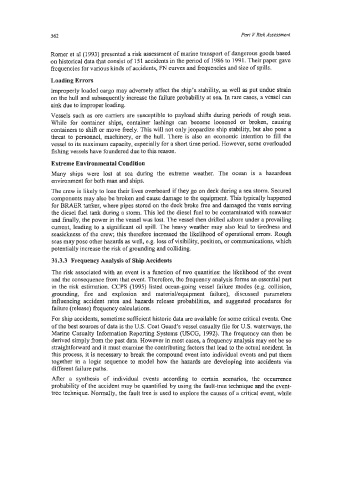Page 586 - Marine Structural Design
P. 586
5 62 Part V Risk Assessment
Romer et a1 (1993) presented a risk assessment of marine transport of dangerous goods based
on historical data that consist of 15 1 accidents in the period of 1986 to 1991. Their paper gave
frequencies for various kinds of accidents, FN curves and frequencies and size of spills.
Loading Errors
Improperly loaded cargo may adversely affect the ship’s stability, as well as put undue strain
on the hull and subsequently increase the failure probability at sea. In rare cases, a vessel can
sink due to improper loading.
Vessels such as ore carriers are susceptible to payload shifts during periods of rough seas.
While for container ships, container lashings can become loosened or broken, causing
containers to shift or move freely. This will not only jeopardize ship stability, but also pose a
threat to personnel, machinery, or the hull. There is also an economic intention to fill the
vessel to its maximum capacity, especially for a short time period. However, some overloaded
fishing vessels have foundered due to this reason.
Extreme Environmental Condition
Many ships were lost at sea during the extreme weather. The ocean is a hazardous
environment for both man and ships.
The crew is likely to lose their lives overboard if they go on deck during a sea storm. Secured
components may also be broken and cause damage to the equipment. This typically happened
for BRAER tanker, where pipes stored on the deck broke free and damaged the vents serving
the diesel fuel tank during a storm. This led the diesel fuel to be contaminated with seawater
and finally, the power in the vessel was lost. The vessel then drifted ashore under a prevailing
current, leading to a significant oil spill. The heavy weather may also lead to tiredness and
seasickness of the crew; this therefore increased the likelihood of operational errors. Rough
seas may pose other hazards as well, e.g. loss of visibility, position, or communications, which
potentially increase the risk of grounding and colliding.
31.3.3 Frequency Analysis of Ship Accidents
The risk associated with an event is a function of two quantities: the likelihood of the event
and the consequence from that event. Therefore, the fiequency analysis forms an essential part
in the risk estimation. CCPS (1995) listed ocean-going vessel failure modes (e.g. collision,
grounding, fire and explosion and materiaVequipment failure), discussed parameters
influencing accident rates and hazards release probabilities, and suggested procedures for
failure (release) frequency calculations.
For ship accidents, sometime sufficient historic data are available for some critical events. One
of the best sources of data is the U.S. Coat Guard’s vessel casualty file for U.S. waterways, the
Marine Casualty Information Reporting Systems (USCG, 1992). The fiequency can then be
derived simply hm the past data. However in most cases, a frequency analysis may not be so
straightforward and it must examine the contributing factors that lead to the actual accident. In
this process, it is necessary to break the compound event into individual events and put them
together in a logic sequence to model how the hazards are developing into accidents via
different failure paths.
After a synthesis of individual events according to certain scenarios, the occurrence
probability of the accident may be quantified by using the fault-tree technique and the event-
tree technique. Normally, the fault tree is used to explore the causes of a critical event, while

